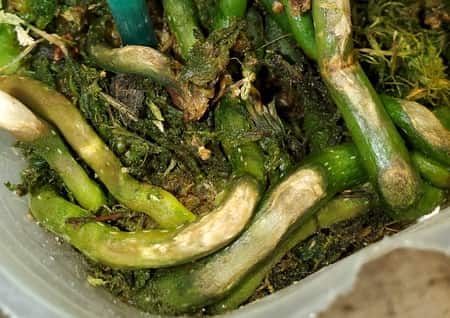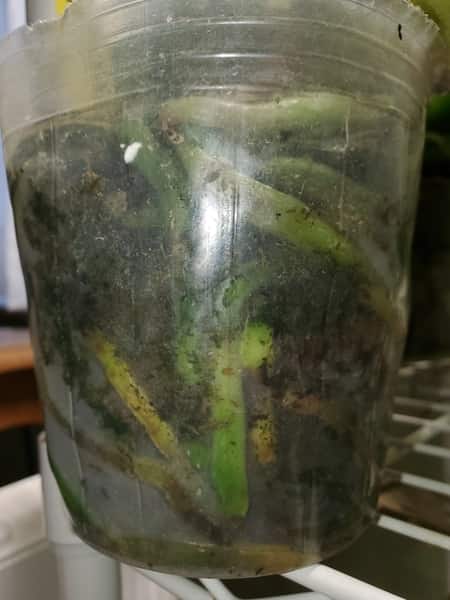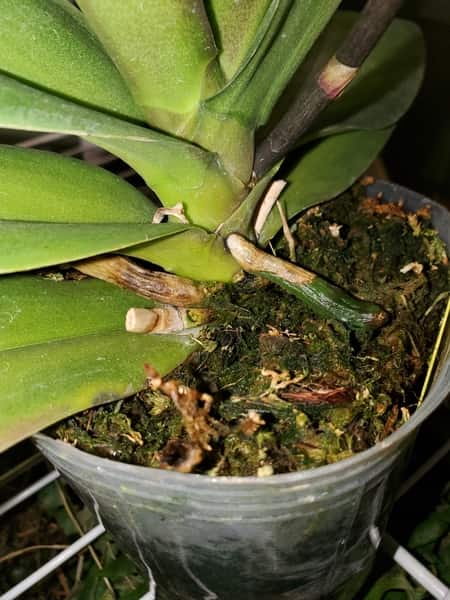If you have a transparent plastic pot, it’s more than probable that at one point or another, you’ll have green slime growing on the sides of the pot. The green algae in orchid pots are not harmful to your orchid, but it’s best if it wasn’t there.
How do you properly eliminate the green algae from the orchid pot? The solution to killing algae is simple: block the light. Place your transparent pot inside a solid pot, with no light. The roots will live long enough for the lack of light to kill off the algae, and you can have a nice-looking pot again.
Another way to eliminate the emerald green algae and the green slime from inside your pots is watering with hydrogen peroxide. The peroxide will convert the water back into hydrogen and oxygen, providing more air presence and circulation in your plant. Just don’t pour the hydrogen peroxide directly onto the roots. Dilute it first. Do green algae hurt the orchid? Algae don’t feed on the roots and aren’t parasitic to the orchid, so in this sense, it doesn’t harm your orchid. Algae feed on the waste products form the orchid, too.
Yet, when it starts to decay, it lowers the pH in the orchid pot, turning the medium more acidic. This decomposition is a perfect habitat for other bacteria, which leads to fungal growth.

Green Algae grows in the presence of light, good fertilizer, and water. The transparent orchid pot with several holes in the sides provides all three, and a bonus of being protected from bugs and pests. So if you have green algae, your orchid is probably pretty happy.
At the very first, when the presence of algae is less, it can be beneficial to your orchid pot because it will trade gases, releasing oxygen into the environment. This is an added plus to the roots, which thrive on air circulation and need oxygen to function properly. Algae can consume some of the toxins that orchid releases and feeds on the decaying roots, which keeps the orchid pot cleaner.
The positive side of algae is that you are watering and fertilizing properly, and the roots have sufficient light. This is why it’s more prevalent to see green mold in newly purchased orchids from a greenhouse than it is in our home environments. Their levels of humidity are much more constant and higher than what we can provide in our homes.

Algae in the orchid pot is a great sign…but you need to get rid of it as soon as possible.
In fact, in Full Water Culture, it has been proven to leave a bit of the original algae in the pot, as it can raise the oxygen levels. It also provides a balancing act between good and bad bacteria.
It’s a winning situation—until it isn’t.
Once the algae build up on the sides of the pot, no light can penetrate the pot. This will promote root decay further. Algae grow extremely fast and in less than three weeks you can have a really bad case of green algae that harms your orchid.
When algae have built up inside the pot, there is no more room for air circulation. Algae has taken over every free space, and airflow is hindered. In this case, algae start to die off (luckily before the roots do) but they in turn can’t fall on to the forest floor, as they would in nature. They just linger around, dead, inside your orchid pot.
Dead material attracts bacteria. Bacteria attract mold. Mold attract fungus. Fungus attracts zombies. Wait…what??? Just kidding. I was making sure you were still reading. 😊
Anyway, other unwanted guests that the green algae attract are fungus gnats (which you can read about in this article, which includes efficient ways to eliminate them) flies. This is the downside of algae: its friends.
Another sign that the water, light, and fertilizing are all on spot, is the presence of the sphagnum turning green on the top of your orchid. Sphagnum moss that’s used in the potting medium is dead and does not revive, contrary to the sphagnum used in terrariums and vivariums. The moss hasn’t come back to life, but the green growth is in fact a beneficial layer of moss growing on the top of the medium.The only real harm at the beginning of the green algae is having to repot. I can tell you from personal experience, that is nasty. No amount of preparation is worth the slime that gets stuck under your nails.
As for treating your orchid with Hydrogen Peroxide 3% to treat the algae problem, there are two methods. You can dilute the hydrogen peroxide and soak your orchid in this medium for a few minutes. Hydrogen Peroxide will interact with living organisms and cells and can eliminate the bad fungus, bacteria, mold, and algae, but it can also kill off the good cells, and your orchid could sense the loss of the good micro-bacteria. It won’t harm the orchid, but it can disrupt the living environments harshly inside your pot.

To Treat Green Algae – Try Hydrogen Peroxide (Affiliate Link) if your case is really bad.
if your case is really bad.
Another way to apply H2O2 is to spray it sparingly on the top of the medium and on the leaves. The leaves for treating algae isn’t necessary, but can be good for bacterial infections and somewhat recuperating sunburn damage. This method is less aggressive to the overall health of your orchid since you’ll be killing the algae slowly, rather than all at one go.
Whatever you do, do not, I repeat do NOT use the Hydrogen Peroxide 35%. This is extremely toxic and used only by professional to clean aquariums with extremely bad cases of algae build-up.
They use professional equipment, masks, gloves, and protective gear to verify their safety and health. In some countries, you can’t even purchase the 35% on the market and have to special order it (which I think is wise). This concentration will eat the skin off your hands… literally. So keep to the 3% that is available in most pharmacies.
Important Tip: To get rid of algae, the best time to do it is during a repot. Take the original pot to the sink and after removing the orchid, scrub it out with all kinds of soaps, detergents, and whatever bleach solutions you have. If you repot your orchid in a pot with only a little green algae on the side, it will grow back to what it once was before.
Green algae on orchid pots will be the first reason you’ll need to repot sooner than the 2 to 3-year time frame. Some more moist orchids, like Phalaenopsis and Phragmipediums, will need to be repotted sooner, around the one-year mark, if you have a strong presence of green slime in your orchid pot.
Don’t Stop Learning!
If you want to be included in more information and get a 14-page fertilization guide, please sign up for my newsletter. I don’t spam, but send emails out bi-monthly with some curious topics of interest. If you want more information, click here to go to a specific page on this website where I explain it more in detail.

Also, if you are looking for an orchid journal to keep your notes specifically about orchid care, check out my 2 solutions for that on this page. If note-keeping isn’t your thing, then there is a free excel spreadsheet that you can download. Click here for more information on how to do that.
If you subscribe to my newsletter, I will send you a 14-page guide on the main tips of orchid fertilizer. It is downloadable and you can print it out on your computer. I designed the guide to double up as a coloring book, just to make it fun.
Further Reading Suggestions:
Don’t just take my word for what is written here. Continue researching other articles about green algae and orchids, because everyone has a different point of view and unique techniques that work for them. Here are a few other articles from other websites if you’d like to continue your research on orchid care for algae:
-“Algal associates and the evidence of cyanobacterial nitrogen fixation in the velamen roots of epiphytic orchids ” written by Azhanthanilkunnathil Sankunny Deepthi, published in Global Ecology and Conservation talks aboutthe important symbiotic relationship between the algae and velamen. According the to this study, “This preliminary level empirical evidence is sufficient to consider the velamen roots of epiphytic orchids as an ecologically complex aerial ‘organ ecosystem’ with microbial partnerships for nutritional support, especially nitrogen availability in epiphytic orchids.” The algae actually aided the nitrogen absorption in the pot.
” written by Azhanthanilkunnathil Sankunny Deepthi, published in Global Ecology and Conservation talks aboutthe important symbiotic relationship between the algae and velamen. According the to this study, “This preliminary level empirical evidence is sufficient to consider the velamen roots of epiphytic orchids as an ecologically complex aerial ‘organ ecosystem’ with microbial partnerships for nutritional support, especially nitrogen availability in epiphytic orchids.” The algae actually aided the nitrogen absorption in the pot.
-“Preventing Problems in the Winter ” written by Steve Klitzing, published in American Orchid Association talks about several problems that arrive during that winter in orchid care, one of them being the green algae production.
” written by Steve Klitzing, published in American Orchid Association talks about several problems that arrive during that winter in orchid care, one of them being the green algae production.
-“Identification of cyanobacterial association from the roots of the terrestrial orchid, Spathoglottis plicata Blum “ written by Arun T. Ram, published in International Journal of Advanced Research talks about the beneficial relationship between green algae and orchid roots.
“ written by Arun T. Ram, published in International Journal of Advanced Research talks about the beneficial relationship between green algae and orchid roots.
If you have an orchid that has green algae, I hope these methods of eliminating the algae without harming the orchid will work. Tell me how it went and if you have any other ideas to keep your orchid alive and healthy—without with the algae in its pot.
Happy Cultivating!

